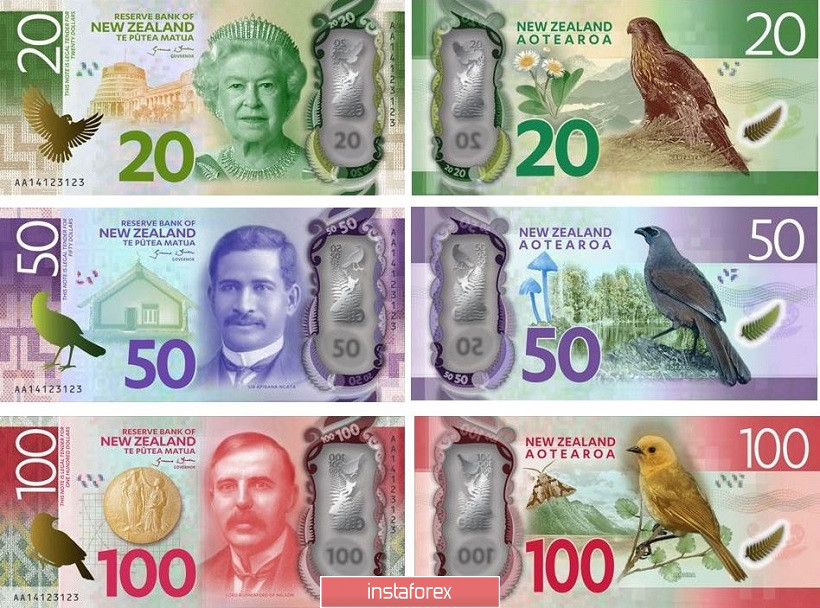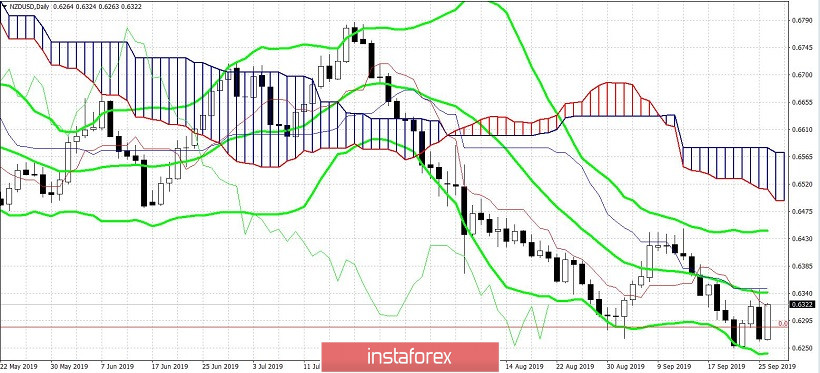Amid high-profile political events in the United States, the market virtually ignored the September meeting of the Reserve Bank of New Zealand. Although it was the RBNZ that drew the line of the onset of the "era of monetary easing" this summer, lowering the interest rate by 50 basis points at once. But this time, the meeting of the regulator turned out to be quite "passing" and surprisingly optimistic. The New Zealand dollar reacted negatively to only one phrase of the head of the RBNZ Adrian Orr - that low-interest rates will remain for a long time, namely for many years. Such hopeless prospects put pressure on the Kiwi, and the pair indicated a local minimum of 0.6260 weeks. Nevertheless, the bears failed to develop downward impulse despite the general strengthening of the American currency. Today, the pair is testing the 63rd figure, remaining within 100-point price range at 0.6250-0.6350.

It is worth noting here that the greenback now dominates almost all dollar pairs. This is especially pronounced in the EUR/USD, GBP/USD AND USD/CHF pairs. But against the backdrop of such hegemony of the buck, the New Zealander is still trying to show character, holding on to his gained position. Naturally, there is no talk of a trend reversal, however, downward prospects are now in great question. In all likelihood, the NZD/USD pair will move sideways in anticipation of the outcome of the US-Chinese talks.
Let me remind you that on the eve of the September RBNZ meeting, many experts (the vast majority) were sure that the regulator would either lower the interest rate or announce its decrease at the last meeting this year - in November. However, members of the New Zealand Central Bank showed a surprisingly restrained position, voicing optimistic assessments regarding the growth prospects of the national economy. So, according to Adrian Orr, the monetary and fiscal stimulus measures taken by the regulator and the government will bring positive results at the beginning of next year. He said that the growth in economic activity will be determined primarily by the growth of government spending, investment, and monetary conditions. Moreover, he virtually ruled out the use of "non-traditional monetary policy instruments" (first of all, we are talking about the notorious QE), repeating that the New Zealand economy is "in fairly good shape."
As you can see, the New Zealand regulator is quite "philosophical" in its assessment of the current situation in the country's economy. After the release of strong data on labor market growth, RBNZ sharply reduces the rate, but now he is optimistic about the prospects for economic development just a few days after the publication of extremely weak data on GDP growth. In September, the regulator decided that "the glass is half full", and thereby supported the "kiwi". Although the data on New Zealand's GDP growth suggests the opposite: the key figures came out at a forecasted level, confirming the slowdown of the national economy. In the second quarter, the indicator grew to only 2.1% (in annual terms), and in quarterly terms by 0.5%. In other words, the New Zealand economy has slowed to its lowest level in five years, reflecting the effects of the global trade conflict.
Nevertheless, the fact remains that the Central Bank of the island state is optimistic about the future, forcing many experts to revise their forecasts. Last week, the probability of a rate reduction to 0.75% at the November meeting was almost one hundred percent. Now, the date of the next reduction has been "moved" to the beginning of 2020. The regulator has made it clear that the Central Bank and the government have taken all necessary (emergency) measures, so further steps in this direction are unnecessary - at least for now. Now the RBNZ has taken a wait and see attitude, especially in light of a possible breakthrough in the negotiations between China and the United States.
Obviously, the regulator has high hopes for the October round of negotiations, since China is the main and largest export market for New Zealand. Therefore, the period of "thaw" in relations between the superpowers also provides indirect support for the New Zealand currency. If next week the parties at least outline the framework of the future deal, the NZD/USD pair will receive a powerful impetus for their growth -at least towards the middle of the 64th figure.

In the meantime, the pair is trading sideways within the range of 0.6250-0.6350 (the lower and middle lines of the Bollinger Bands indicator on the daily chart). If the pair overcomes the upper boundary of the indicated range, the next resistance level will be 0.6440, which is the upper line of the Bollinger Bands on the same timeframe.
 English
English 
 Русский
Русский Bahasa Indonesia
Bahasa Indonesia Bahasa Malay
Bahasa Malay ไทย
ไทย Español
Español Deutsch
Deutsch Български
Български Français
Français Tiếng Việt
Tiếng Việt 中文
中文 বাংলা
বাংলা हिन्दी
हिन्दी Čeština
Čeština Українська
Українська Română
Română

